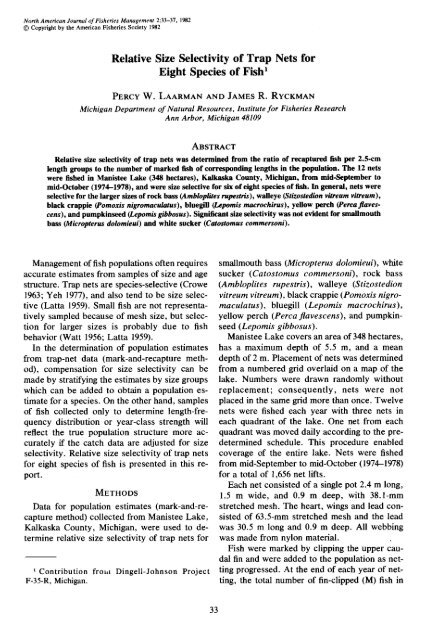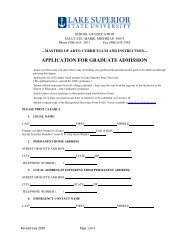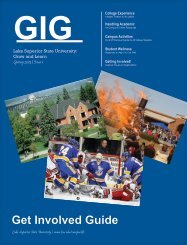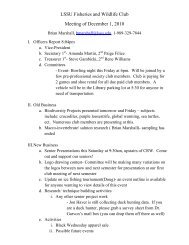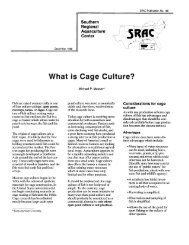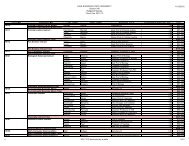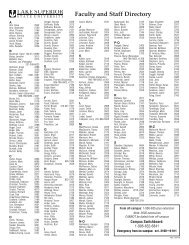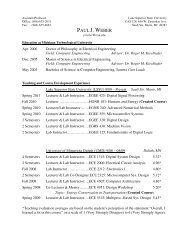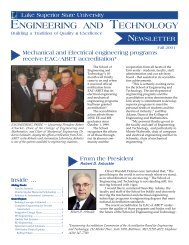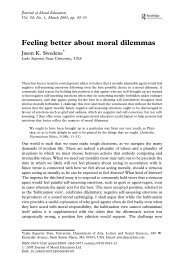Laarman and Ryckman - Lake Superior State University
Laarman and Ryckman - Lake Superior State University
Laarman and Ryckman - Lake Superior State University
You also want an ePaper? Increase the reach of your titles
YUMPU automatically turns print PDFs into web optimized ePapers that Google loves.
North American Journal of Fisheries Management 2:33-37, 1982<br />
¸ Copyright by the American Fisheries Society 1982<br />
Relative Size Selectivity of Trap Nets for<br />
Eight Species of Fish'<br />
PERCY W. LAARMAN AND JAMES R. RYCKMAN<br />
Michigan Department of Natural Resources, Institute for Fisheries Research<br />
Ann Arbor, Michigan 48109<br />
ABSTRACT<br />
Relative size selectivity of trap nets was determined from the ratio of recaptured fish per 2.5-cm<br />
length groups to the number of marked fish of corresponding lengths in the population. The 12 nets<br />
were fished in Manistee <strong>Lake</strong> (348 hectares), Kalkaska County, Michigan, from mid-September to<br />
mid-October (1974-1978), <strong>and</strong> were size selective for six of eight species of fish. In general, nets were<br />
selective for the larger sizes of rock bass (Atnbloplites rupestr/s), walleye (Stizostedion vitreurn vitreurn),<br />
black crappie (Pomoxis nigromaculatus), bluegill (Lepomis macrochirus), yellow perch (Perca fiavescens),<br />
<strong>and</strong> pumpkinseed (Lepotnis gibbosus). Significant size selectivity was not evident for smallmouth<br />
bass (Micropterus dolomieui) <strong>and</strong> white sucker (Catostomus commersoni).<br />
Management of fish populations often requires smallmouth bass (Micropterus dolomieui), white<br />
accurate estimates from samples of size <strong>and</strong> age sucker (Catostomus commersoni), rock bass<br />
structure. Trap nets are species-selective (Crowe (Ambloplites rupestris), walleye (Stizostedion<br />
1963; Yeh 1977), <strong>and</strong> also tend to be size selec- vitreurn vitreurn), black crappie (Pomoxis nigrotive<br />
(Latta 1959). Small fish are not representa- rnaculatus), bluegill (Lepornis macrochirus),<br />
tively sampled because of mesh size, but selec- yellow perch (Perca fiavescens), <strong>and</strong> pumpkintion<br />
for larger sizes is probably due to fish seed (Lepomis gibbosus).<br />
behavior (Watt 1956; Latta 1959).<br />
Manistee <strong>Lake</strong> covers an area of 348 hectares,<br />
In the determination of population estimates has a maximum depth of 5.5 m, <strong>and</strong> a mean<br />
from trap-net data (mark-<strong>and</strong>-recapture meth- depth of 2 m. Placement of nets was determined<br />
od), compensation for size selectivity can be from a numbered grid overlaid on a map of the<br />
made by stratifying the estimates by size groups lake. Numbers were drawn r<strong>and</strong>omly without<br />
which can be added to obtain a population es- replacement; consequently, nets were not<br />
timate for a species. On the other h<strong>and</strong>, samples placed in the same grid more than once. Twelve<br />
of fish collected only to determine length-fre- nets were fished each year with three nets in<br />
quency distribution or year-class strength will each quadrant of the lake. One net from each<br />
reflect the true population structure more ac- quadrant was moved daily according to the precurately<br />
if the catch data are adjusted for size determined schedule. This procedure enabled<br />
selectivity. Relative size selectivity of trap nets coverage of the entire lake. Nets were fished<br />
for eight species of fish is presented in this re- from mid-September to mid-October (1974-1978)<br />
port.<br />
for a total of 1,656 net lifts.<br />
Each net consisted of a single pot 2.4 m long,<br />
METHODS<br />
1.5 m wide, <strong>and</strong> 0.9 m deep, with 38. l-mm<br />
Data for population estimates (mark-<strong>and</strong>-re- stretched mesh. The heart, wings <strong>and</strong> lead concapture<br />
method) collected from Manistee <strong>Lake</strong>, sisted of 63.5-mm stretched mesh <strong>and</strong> the lead<br />
Kalkaska County, Michigan, were used to de- was 30.5 m long <strong>and</strong> 0.9 m deep. All webbing<br />
termine relative size selectivity of trap nets for was made from nylon material.<br />
Fish were marked by clipping the upper caudal<br />
fin <strong>and</strong> were added to the population as net-<br />
• Contribution frohx Dingell-Johnson Project ting progressed. At the end of each year of net-<br />
F-35-R, Michigan.<br />
ting, the total number of fin-clipped (M) fish in<br />
33
34 LAARMAN AND RYCKMAN<br />
Table 1. Number of marked <strong>and</strong> recaptured fish<br />
caught with trap nets in Manistee <strong>Lake</strong>,<br />
1974-1978.<br />
Species<br />
Length Number<br />
range •<br />
(cm) Marked Recaptured<br />
Bluegill 10.2-22.7 13,670 486<br />
Pumpkinseed 10.2-22.7 20,105 1,125<br />
Rock bass 10.2-25.2 1,830 190<br />
Black crappie 12.7-32.8 5,827 693<br />
Yellow perch 12.7-32.8 3,775 104<br />
Walleye 25.4-58.2 3,063 366<br />
Smallmouth bass 15.2-32.8 3,093 322<br />
White sucker 38.1-58.2 1,772 77<br />
a Fish outside of the length ranges were captured occasion-<br />
ally, but in low numbers.<br />
2O<br />
R/M -266530 + 35.330 L- 1.4531' + 0.0193E<br />
(R'=O.18)<br />
•15 / • /<br />
• / \<br />
• / •• //<br />
a. /•<br />
•5 / /•<br />
/<br />
/<br />
i I I I i<br />
15 20 25 50 55<br />
Length (cm)<br />
Fibre 1, RelaQo•hip bet•ee• the pe•ce•Se<br />
the population <strong>and</strong> the number of recaptured (R)<br />
fish were determined. The end result was five R/ (•2 st•d•d errors).<br />
M ratios (one per year) for each 2.5-cm length<br />
group per species. No attempt was made to determine<br />
R/M ratios from fish marked in one year bass (Fig. 3). Although the general trend was an<br />
<strong>and</strong> recaptured in later years. Relationships be- increase in catchability with size, the extreme<br />
tween R/M values <strong>and</strong> total lengths of fish were yearly variation gave a low R 2 value of 0.22.<br />
determined by polynomial regressions. The R/M Rock bass from Fife <strong>Lake</strong> showed a uniformly<br />
values for the mid-point of each 2.5-cm length upward trend, but data from Whitmore <strong>and</strong> Suggroup<br />
represent relative efficiency indices, <strong>and</strong> arloaf lakes were more erratic (Latta 1959). Nets<br />
the application of these indices is discussed be- were selective for walleyes greater than 55 cm,<br />
low.<br />
but a significant difference in catchability was<br />
not detectable for smaller fish (Fig. 4).<br />
RESULTS AND DISCUSSION<br />
Total numbers of fish marked <strong>and</strong> recaptured<br />
There was a general increase in catchability<br />
from 1974 to 1978 are given in Table 1 by<br />
species. Fish shorter <strong>and</strong> longer than the indicated<br />
lengths were captured occasionally but in<br />
very low numbers.<br />
Calculated curves, with 95% confidence limio<br />
9<br />
8<br />
RIM -2.773 + 0,173L<br />
(R' = 0.12)<br />
its, showing the relationships between R/M val- g7<br />
ues <strong>and</strong> total lengths of fish are given in Figs.<br />
1-8. Size selectivity was evident for all species<br />
except smallmouth bass <strong>and</strong> white suckers<br />
(Figs. 1 <strong>and</strong> 2). Low coefficient of determination<br />
• 6<br />
(R 2) values of 0.18 (smallmouth bass) <strong>and</strong> 0.12<br />
(white sucker) indicated much variation in the<br />
3<br />
data for both species. Latta (1959) reported<br />
2<br />
more variation in R/M percentages for largemouth<br />
bass (Micropterus salmoides) than for<br />
i<br />
other species in Whitmore <strong>and</strong> Fife lakes <strong>and</strong> no<br />
40 45 50 55 60<br />
general trend in size selectivity. In the same<br />
Length (cm)<br />
study, however, Latta (1959) reported size-spe- Figure 2. Relationship between the percentage<br />
cific catchability for white suckers from Fife of recapture of marked white suckers (R/M)<br />
<strong>Lake</strong>.<br />
<strong>and</strong> length (L) in Manistee <strong>Lake</strong>, 1974-1978<br />
Size selectivity was barely detectable for rock (+-2 st<strong>and</strong>ard errors).
24<br />
22 R/M = -6.190 + 0 937 L //<br />
20 (R' =0 22) //<br />
18 /<br />
/<br />
/<br />
/<br />
Length (cml<br />
Figure 3. Relationship between the percentage<br />
of recapture of marked rock bass (R/M) <strong>and</strong><br />
length (L) in Manistee <strong>Lake</strong>, 1974-1978 (---2<br />
st<strong>and</strong>ard errors).<br />
of black crappie (Fig. 5) with an increase in size<br />
(R 2 value of 0.45). For bluegills, an increase in<br />
percentage of recaptures occurred up to 20 cm<br />
<strong>and</strong> remained relatively constant for larger fish<br />
(Fig. 6). In an earlier study in Michigan (Latta<br />
1959), bluegill data from Sugarloaf, Whitmore,<br />
<strong>and</strong> Fife lakes also indicated a. general increase<br />
in R/M percentages with increases in length.<br />
A linear relationship best described size selectivity<br />
for yellow perch <strong>and</strong> pumpkinseeds<br />
(Figs. 7 <strong>and</strong> 8). The respective R 2 values of 0.61<br />
Length (cm)<br />
Figure 4. Relationship between the percentage<br />
of recapture of marked walleyes (R/M) <strong>and</strong><br />
length (L) in Manistee <strong>Lake</strong>, 1974-1978 (-+2<br />
st<strong>and</strong>ard errors).<br />
//<br />
SIZE SELECTIVITY OF TRAP NETS 35<br />
/<br />
/<br />
/<br />
22<br />
2O<br />
'E<br />
el2<br />
18<br />
16<br />
•. •0<br />
6<br />
4<br />
2<br />
R/M -5.702+ 0.'725 L<br />
/<br />
/<br />
I<br />
• •5<br />
/<br />
/<br />
(R' =O.45) /<br />
/<br />
/<br />
/<br />
//<br />
//<br />
I I I<br />
20 25 30<br />
Length (cm)<br />
Figure 5. Relationship between the percentage<br />
of recapture of marked black crappies (R/M)<br />
<strong>and</strong> length (L) in Manlstee <strong>Lake</strong>, 1974-1978<br />
(-+2 st<strong>and</strong>ard errors).<br />
7[ R/M = _ 18 810 + 2 354 L - 0 0586 L'<br />
•1- / / /<br />
•/ / / /<br />
I¸ /// 1•5<br />
Length Icml<br />
Figure 6. Relationship between the percentage<br />
of recapture of marked bluegills (R/M) <strong>and</strong><br />
length (L) in Manistee <strong>Lake</strong>• 1974-1978 (-+•<br />
st<strong>and</strong>ard errors).
36 LAARMAN AND RYCKMAN<br />
2O<br />
R/M = -13.04 + 0.917L (R'= 0.61)<br />
/<br />
I0 15 20 25 30 35<br />
Length (cm)<br />
Fibre 7. Rein•anship between the percen•e<br />
of re•pture of marked ye•ow perch (• •d<br />
length (L)<br />
st•dard errors).<br />
Table 2. Comparison between empirical catch<br />
<strong>and</strong> adjusted catch of pumpkinseeds in Manistee<br />
<strong>Lake</strong>, 1977.<br />
Length<br />
Midpoint<br />
a Percent Percent<br />
groups RIM Empirical of Adjusted b of<br />
(cm) ratio catch total catch total<br />
10.2-12.5 0.2 349 6.7 1,745 67.3<br />
12.6-15.1 3.1 944 18.2 305 11.8<br />
15.2-17.6 6.2 2,355 45.4 380 14.7<br />
17.7-20.2 9.4 1,488 28.7 158 6.0<br />
20.3-22.7 12.4 54 1.0 4 0.2<br />
Totals 5,190 100 2,592 100<br />
a Calculated from Fig. 8.<br />
b The empirical catch divided by the RIM ratio for each<br />
length group.<br />
portion of the adjusted catch per length group<br />
to the total catch should remain constant. The<br />
<strong>and</strong> 0.64 for yellow perch <strong>and</strong> pumpkinseed length frequency of the sample was considerably<br />
were the largest of all the species.<br />
changed after adjustment was made for size se-<br />
Catch of pumpkinseeds from Manistee <strong>Lake</strong> lectivity of trap nets. For example, the empirical<br />
in 1977 was used as an example to show how catch data indicated that about 45% of the<br />
catch data are changed when adjusted for net pumpkinseed population were 15.2-17.6 cm<br />
selectivity (Table 2). The R/M ratio for each fish long, but the adjusted catch showed only 14.7%<br />
length is a relative efficiency index of size se- of the population were in that size group. The<br />
lectivity of trap nets. Adjusted catch was deter- greatest difference in length frequency was evmined<br />
by dividing the empirical catch for each ident in the 10.2-12.5 cm group; 6.7% in the emlength<br />
group by the R/M ratio of the midpoint pirical catch compared to 67.3% in the adjusted<br />
of corresponding length groups. Since extended catch.<br />
periods of netting would change the absolute Some aspect of size-specific fish behavior<br />
R/M values, the absolute numbers in the adjust- must be responsible for size selectivity of trap<br />
ed catch are not important. However, the pro- nets, but field observations have not isolated the<br />
controlling factors. Latta (1963) reported that<br />
the larger, tagged smallmouth bass at Waugosb-<br />
I(• R/M = -13.576 + 1.216L<br />
(R '= 0.64)<br />
/<br />
//<br />
/<br />
ance Point, <strong>Lake</strong> Michigan, traveled farther than<br />
smaller bass <strong>and</strong> thus were captured more frequently<br />
in trap nets, but size selectivity for that<br />
species was not evident in Manistee <strong>Lake</strong>.<br />
If rate of escapement of fish from trap nets<br />
was size selective, the R/M values per size group<br />
•-<br />
could be affected. Patriarcbe (1968) investigated<br />
the rate of escapement of several species of fish<br />
from trap nets in two small Michigan lakes <strong>and</strong><br />
concluded that smaller pumpkinseeds <strong>and</strong> white<br />
suckers escaped more readily than larger fish,<br />
IO 15 20 25 but the rate of escapement was not significantly<br />
Len9th Icm)<br />
size specific for bluegills.<br />
Figure 8. Relationship between the percentage Undoubtedly fish behavior <strong>and</strong>, consequently,<br />
of recapture of marked pumpkinseeds (R/M) size selectivity varies seasonally <strong>and</strong> in different<br />
<strong>and</strong> length (L) in Manistee <strong>Lake</strong>, 1974-1978 habitats. Forney (1961) reported that trap nets<br />
(-+2 st<strong>and</strong>ard errors).<br />
were selective for older age groups of walleyes
in the fall but, during the spring spawning run,<br />
size selectivity was not apparent in Oneida<br />
<strong>Lake</strong>, New York. The data from Manistee <strong>Lake</strong><br />
included 5 years of netting when surface water<br />
temperatures ranged from 9 C to 20 C <strong>and</strong>,<br />
therefore should be representative of relatively<br />
shallow lakes during September <strong>and</strong> October.<br />
However, the relative efficiency indices presented<br />
for trap nets in Manistee <strong>Lake</strong> may not<br />
be valid for other times of year or in lakes with<br />
different environmental conditions.<br />
ACKNOWLEDGMENTS<br />
W. C. Latta reviewed the manuscript <strong>and</strong><br />
Alan D. Sutton drafted the figures.<br />
REFERENCES<br />
CROWE, W. R. 1953. An analysis of the fish popula-<br />
tion of Big Bear <strong>Lake</strong>, Otsego County, Michigan.<br />
Papers of the Michigan Academy of Science,<br />
Arts, <strong>and</strong> Letters 38( 1952): 187-206.<br />
SIZE SELECTIVITY OF TRAP NETS 37<br />
FORNEY, J. L. 1961. Year-class distribution of wall-<br />
eyes collected by five types of gear. Transactions<br />
of the American Fisheries Society 90:308-311.<br />
L^TT^, W. C. 1959. Significance of trap net selectiv-<br />
ity in estimating fish population statistics. Papers<br />
of the Michigan Academy of Science, Arts, <strong>and</strong><br />
Letters 44:123-138.<br />
LATrA, W. C. 1963. The life history of the smallmouth<br />
bass, Micropterus d. dolomieui, at Waugoshance<br />
Point, <strong>Lake</strong> Michigan. Michigan Department of<br />
Conservation, Institute for Fisheries Research<br />
Bulletin 5, Ann Arbor, Michigan, USA.<br />
PATRIARCnE, M. H. 1968. Rate of escape of fish from<br />
trap nets. Transactions of the American Fisheries<br />
Society 97:59-61.<br />
WATt, K. E. F. 1956. The choice <strong>and</strong> solution of<br />
mathematical models for predicting <strong>and</strong> maximiz-<br />
ing the yield of a fishery. Journal of the Fisheries<br />
Research Board of Canada 13:613-645.<br />
YEn, C. F. 1977. Relative selectivity of fishing gear<br />
used in a large reservoir in Texas. Transactions<br />
of the American Fisheries Society 106:309-313.


